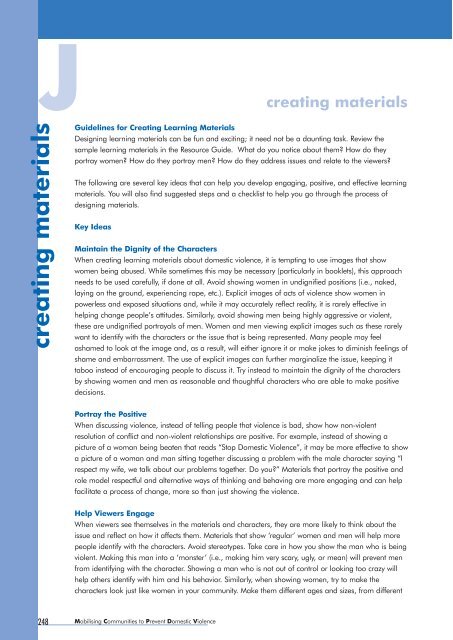CA C 1 - Raising Voices
CA C 1 - Raising Voices
CA C 1 - Raising Voices
Create successful ePaper yourself
Turn your PDF publications into a flip-book with our unique Google optimized e-Paper software.
creating materials<br />
248<br />
creating materials<br />
Guidelines for Creating Learning Materials<br />
Designing learning materials can be fun and exciting; it need not be a daunting task. Review the<br />
sample learning materials in the Resource Guide. What do you notice about them? How do they<br />
portray women? How do they portray men? How do they address issues and relate to the viewers?<br />
The following are several key ideas that can help you develop engaging, positive, and effective learning<br />
materials. You will also find suggested steps and a checklist to help you go through the process of<br />
designing materials.<br />
Key Ideas<br />
Maintain the Dignity of the Characters<br />
When creating learning materials about domestic violence, it is tempting to use images that show<br />
women being abused. While sometimes this may be necessary (particularly in booklets), this approach<br />
needs to be used carefully, if done at all. Avoid showing women in undignified positions (i.e., naked,<br />
laying on the ground, experiencing rape, etc.). Explicit images of acts of violence show women in<br />
powerless and exposed situations and, while it may accurately reflect reality, it is rarely effective in<br />
helping change people’s attitudes. Similarly, avoid showing men being highly aggressive or violent,<br />
these are undignified portrayals of men. Women and men viewing explicit images such as these rarely<br />
want to identify with the characters or the issue that is being represented. Many people may feel<br />
ashamed to look at the image and, as a result, will either ignore it or make jokes to diminish feelings of<br />
shame and embarrassment. The use of explicit images can further marginalize the issue, keeping it<br />
taboo instead of encouraging people to discuss it. Try instead to maintain the dignity of the characters<br />
by showing women and men as reasonable and thoughtful characters who are able to make positive<br />
decisions.<br />
Portray the Positive<br />
When discussing violence, instead of telling people that violence is bad, show how non-violent<br />
resolution of conflict and non-violent relationships are positive. For example, instead of showing a<br />
picture of a woman being beaten that reads “Stop Domestic Violence”, it may be more effective to show<br />
a picture of a woman and man sitting together discussing a problem with the male character saying “I<br />
respect my wife, we talk about our problems together. Do you?” Materials that portray the positive and<br />
role model respectful and alternative ways of thinking and behaving are more engaging and can help<br />
facilitate a process of change, more so than just showing the violence.<br />
Help Viewers Engage<br />
When viewers see themselves in the materials and characters, they are more likely to think about the<br />
issue and reflect on how it affects them. Materials that show ‘regular’ women and men will help more<br />
people identify with the characters. Avoid stereotypes. Take care in how you show the man who is being<br />
violent. Making this man into a ‘monster’ (i.e., making him very scary, ugly, or mean) will prevent men<br />
from identifying with the character. Showing a man who is not out of control or looking too crazy will<br />
help others identify with him and his behavior. Similarly, when showing women, try to make the<br />
characters look just like women in your community. Make them different ages and sizes, from different<br />
Mobilising Communities to Prevent Domestic Violence

















